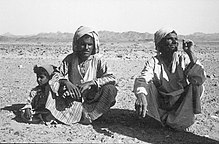Ababda people
This article is largely based on an article in the out-of-copyright Encyclopædia Britannica Eleventh Edition, which was produced in 1911. (April 2016) |
 | |
| Total population | |
|---|---|
| 250,000 (1989) | |
| Regions with significant populations | |
| Egypt, Sudan | |
| Languages | |
| Arabic, English (in Sudan) | |
| Religion | |
| Islam (Sunni) | |
| Related ethnic groups | |
| other Beja |
The Ababda or Ababde – the Gebadei of Pliny, and possibly the Troglodytes of other classical writers – are nomads living in the area between the Nile and the Red Sea, in the vicinity of Aswan in Egypt and north Sudan. Secondary sources in European languages often describe them as a Beja tribe, but they do not consider themselves Beja, and are not considered so by other Beja peoples. There is no evidence that they historically spoke Beja rather than Arabic.[1]
Contents
Overview[edit]
The Ababda extend from the Nile at Aswan to the Red Sea, and reach northward to the Qena-Quseir road, thus occupying the southern border of Egypt east of the Nile. They call themselves "sons of the Jinns." With some of the clans of the Bisharin and possibly the Hadendoa, they represent the Blemmyes of classic geographers, and their location today is almost identical with that assigned them in Roman times.[2]
From time immemorial, they have acted as guides to caravans through the Nubian desert and up the Nile valley as far as Sennar. They intermarried with the Nubians, and settled in small colonies at Shendi and elsewhere up to Muhammad Ali's conquest of the region in the early 19th century. They are still great trade carriers and visit very distant districts.[2]
See also[edit]
References[edit]
- ^ ضرار, محمّد صالح (2012). تاريخ شرق السودان: ممالك البجة‥ قبائلها وتاريخها. Khartoum: مكتبة التوبة. p. 36.
- ^ a b
 One or more of the preceding sentences incorporates text from a publication now in the public domain: Chisholm, Hugh, ed. (1911). "Abābda". Encyclopædia Britannica. 1 (11th ed.). Cambridge University Press. p. 5.
One or more of the preceding sentences incorporates text from a publication now in the public domain: Chisholm, Hugh, ed. (1911). "Abābda". Encyclopædia Britannica. 1 (11th ed.). Cambridge University Press. p. 5.


No comments:
Post a Comment